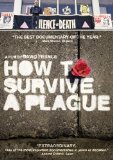| Reviews & Columns |
|
Reviews DVD TV on DVD Blu-ray 4K UHD International DVDs In Theaters Reviews by Studio Video Games Features Collector Series DVDs Easter Egg Database Interviews DVD Talk Radio Feature Articles Columns Anime Talk DVD Savant Horror DVDs The M.O.D. Squad Art House HD Talk Silent DVD
|
DVD Talk Forum |
|
|
| Resources |
|
DVD Price Search Customer Service #'s RCE Info Links |
|
Columns
|
|
|
How to Survive a Plague
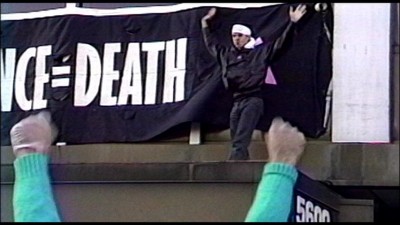
The headline-grabbing efforts of AIDS-awareness/advocacy protest group ACT-UP (AIDS Coalition to Unleash Power) didn't happen all that long ago. But, thanks in large part to the effectiveness of their controversial tactics (nonviolent but aggressive marches, sit-ins, obstructions, and shut-downs) and the ultimate successful attainment of their political aims, ACT-UP's most active years -- from 1987, when the group was founded, to the mid-1990s, when combination-drug "cocktail" therapy began prolonging the lives of persons with HIV, often all the way back to normal life spans -- are now settled enough in the past to qualify as history of the sort that can be surveyed in a film like David France's Oscar-nominated documentary How to Survive a Plague. France, a renowned journalist and author who was himself on the ACT-UP beat for New York magazine, has gone back into the archives of national and local media and, especially, into the video footage made by individual ACT-UP members and under the organization's own confrontational but savvy public-relations auspices, to tell the story of its parlaying the inchoate anger of a decimated, reviled population of those who contracted AIDS (a great many of whom were already-marginalized gay men) into a potent political machine. It's a story that's clearly well worth telling, and France has undertaken to use the lifetime of the group as a year-by-year chronological narrative, from 1987 to 1996, around which to organize and offer up a cornucopia of archival footage from those years, presenting a broad, non-monolithic view of people with AIDS, of course, but also of our nation's political climate in what seemed, to those on the left in general and those facing the urgent, life-or-death matter of AIDS (Reagan, notoriously, wouldn't utter the name of the syndrome until he couldn't possibly ignore the matter any longer) very specifically -- a climate in which fighting or dying (or "silence=death," as the famous ACT-UP slogan put it) were the only two options available.
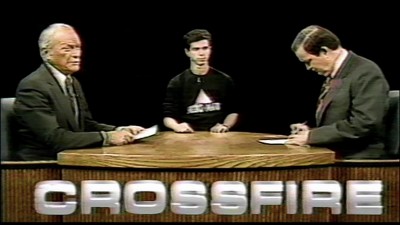
The individual faces of ACT-UP presented here -- the "characters" France has chosen to focus on -- are varied: The principal protagonists, whose involvement with the group France most consistently and completely follows from '87 to the present (in the cases where they have survived), are former stockbroker Peter Staley, who felt he was given a death sentence when diagnosed as HIV-positive in 1986, realized the FDA and drug companies were ignorant and/or dragging their feet, and had a personal/political awakening that brought him well away from Wall Street to go for broke in a different milieu altogether; film archivist Mark Harrington, who became a sort of de facto video spokesperson for the group, articulating succinct and provocative communiqués for broadcast; avant-grade playwright Jim Eiger; and the late Bob Rafsky, a man who came out of the closet later in his life only to be stricken with the dread disease and who, perhaps because of his own rich personal experience (snippets from annual home videos of him celebrating successive birthdays with his ex-wife and daughter punctuate the film), became ACT-UP's most passionate and articulate speechmaker and chant-leader (at one point midway through the film, circa 1992, we see footage of him heckling and confronting candidate/future president Bill Clinton about governmental homophobia and inaction).
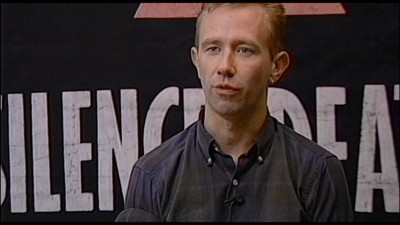
These central figures give us recurrent points of reference (we can recognize them frequently in the generous swathes of meeting/protest footage France has curated, and Paley, Harrington, and Eiger -- though, sadly, not Rafsky -- have been interviewed in the present, too) around which far-flung constellations of other activist's experiences and stories can revolve. A host of voices in addition to the central ones speaks to us both from the past (as recorded on video in the thick of the melee), and also sometimes in the present day, in interviews conducted by France for the film: Researchers from Merck, the first drug company to cooperate with AIDS activists; representatives of the National Institute of Health, which, along with the FDA, was the frequent target of ACT-UP protest and resistance for its lackadaisical approach to approving treatments while people were dying; and the anonymous bulk of the group who never rose to prominence or official leadership, the diverse rank and file, which encompassed everyone from Garance Frank-Ruth, a wannabe-bohemian teenager when she got involved in ACT-UP who became one of the most steadfast and bold protestors, to the late performance artist Ray Navarro and his campy, irreverent implorations to safer sex, to a housewife/retired chemist called Iris Long, who planted the seeds of what became an impressive medical/scientific self-education on the part of the AIDS community, to the point that they were eventually able to speak to the "experts" in the government and at the drug companies in their own language, seeing through any evasion tactics. (Of course, no delve into the history of the AIDS crisis would be complete without playwright/novelist/agitator extraordinaire Larry Kramer, and so that perpetual curmudgeon, conscience of the gay community, and co-founder of the Gay Men's Health Crisis, the first institution to take note of and address the rise of HIV, makes an unusually lucid appearance, as well.) With this chorus of voices harmonizing and sometimes becoming a cacophony (France doesn't shy away from some internecine conflicts in the group -- disagreements over tactics and negotiations, resistance to any "elitism" that would make one faction's voice more powerful than any other's), the film becomes a varied patchwork of distinctive personalities from widespread factions and levels of the organization whose connections one to another are clear enough to make for a comprehensible (if not comprehensive) whole -- a good cross-section of those who were concerned or, more often, righteously angry enough to get out in the streets (often getting arrested for their civil disobedience) and invade the corridors of power to fight the good fight.
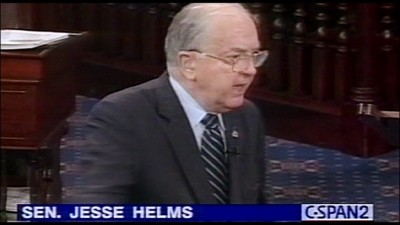
France wisely focuses much more on immediate exposure to the chaotic history with all of its heated meetings and dynamic protest actions than on the becalmed, reflective present-day remembrances; there's probably a good three-to-one ratio of moments that put us back in the late '80s and early '90s, in the thick of ACT-UP's struggle, to ones that that give us lucid, encapsulating (and, sometimes, quite moving) backward glances and ruminations. In addition to selecting the several aforementioned long-term and prominent founders/organizers as an anchor around which to let the other "characters" ebb and flow, he's structured the film along a very straightforward timeline, 1987-1996, each new year announcing itself in an intertitle along with the number of AIDS deaths to date worldwide. This limits the film in a way, but it's also necessary; there are moments where the breadth of France's project, the million competing details of the plague years, threatens to rob it of its focus, for example a montage of marchers accompanying the memorial AIDS quilt to Washington that doesn't quite fit, coming off more as an obligatory acknowledgment than anything directly to do with ACT-UP (entire documentaries have already been devoted to those specific, memorializing and mourning aspects of AIDS history in the form of, respectively, Rob Epstein's Common Threads: Stories from the Quilt and Bill Weber's more recent We Were Here). The film's signposts, oversimplifying as they inevitably are, provide a welcome sort of rigor for us, and one imagines they did for France as well, as he must have had hundreds of hours of footage to hone into some kind of "story" with a discernible narrative shape.
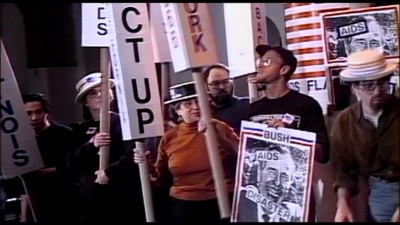
On the other hand, though, the obvious need to fit the extremely complicated and multifaceted history of ACT-UP into such a determining, unavoidably reductive pattern inescapably conventionalizes a most unconventional movement (some of France's template choices of music and montage doesn't help matters, though things remain immediate enough generally to maintain impact). It's a good, respectful, engaged, and overall principled work, but it seems too pat nevertheless, as if there's something vaguely missing; it may be that there's an endemic weakness to the documentary approach when it comes to getting to the heart of the matter and making the history of the AIDS crisis come alive now that it's no longer such a crisis (thanks, in large part, to ACT-UP's victories). There's no denying how informative, dedicated, and even rousing France's film is, and it's a valuable document, most particularly as an enlightening introduction or reminder for those (the majority) who were out of the loop from '87 to '96, either because they weren't directly affected at the time or are too young to remember it for themselves. But this reviewer is just old enough to recall being aware of a cultural history that formed around the AIDS crisis, a wave of art that meant to do what no documentary can, somehow encapsulating and expressing the inexpressible horror of a pernicious, fatal, domino-effect medical disaster compounded many times over by social and political prejudice, indifference, and something ultimately rotten at the heart of a "traditional" culture that hesitated, hemmed, hawed, and did nothing much more than get squeamish, embarrassed, and reactionary as hundreds of thousands of gay men (and, obviously, not only gay men) died. We see footage in How to Avoid a Plague of ACT-UP arch-nemesis Jesse Helms -- a senator from North Carolina and notorious racist and homophobe who will live forever in ignominy -- disgustedly and petulantly demanding (from the Senate floor, no less) that gay men take their sexuality and what he perceives as "their" illness back into the closet to die without upsetting his delicate, homophobic sensibilities; and we see the activists' retaliation, their trespassing and unrolling of a larger-than-life condom, emblazoned with anti-Helms and pro-safe-sex messages, from the roof down to the foundation of the Helms residence back in Dixie. But I remember that what really got Helms's goat was the work of gay artists like Robert Mapplethorpe and, most relevantly, that of the great filmmaker Todd Haynes, whose 1991 debut feature, Poison, caused a furor by parlaying its tiny allowance of public funding (1/10 of its already-minuscule budget) into a graphic, inspiredly creative, purposely upsetting narrative film that vividly and indelibly tied together themes of homophobia, homoeroticism, ostracization, and AIDS into something deeply disconcerting and genuinely provocative; avoidance of visceral feeling and an understanding beyond polemics or day-and-date history was not an option in the face of such a film. Something like How to Survive a Plague gives you the facts and the testimony, and those are extremely important things; it's not a history whose facts should ever be forgotten, and getting them down into a document is vital. When it comes to deeper thought, further implication, and more insistent demands for recognition and empathy, though, it may be that documentary gives us the facts, but forms less beholden to "reality" give us more access to the Truth.
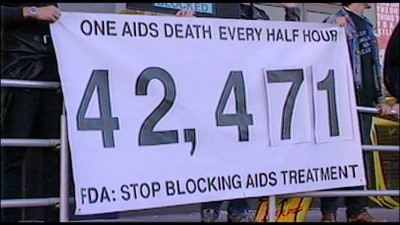
Video:
The anamorphic-widescreen transfer (preserving the original theatrical aspect ratio of 1.85:1) is easily able to reflect the film's look, which mostly means very washed-out, old-school VHS-type video along with some graphics and contemporary interviews in high-definition. Most flaws seem due to the sources, not the transfer; the only flaw I could detect was some intermittent edge enhancement/haloing in some scenes, which may have been the necessary result of making some of the camcorder-type footage watchable. In all, the transfer does an excellent job of bringing home a look that never meant to be anything like pristine in the first place, but rather to reflect a specific, accurate, and necessary blurry-video, late-'80s/early-'90s camcorder/TV news aesthetic.
Sound:The disc offers both Dolby Digital 2.0 stereo and Dolby Digital 5.1 surround tracks. The latter is the go-to set-up choice, reflecting the full theatrical sound (though both tracks are as clear and vivid as the source materials will allow for), with good, clear sound throughout (even with the very limited sound capabilities of some of the recording devices used from the late '80s through the mid-'90s, only a few scenes are subtitled for clarity*) and an impressive aural immersion at times, for example in the chaos of some of the footage of heated ACT-UP meetings and mass public protests.
*Also included are English SDH and Spanish-language subtitle options.
Extras:--A feature-length audio commentary with director David France, who, rather than commenting too much directly on the film as it plays, interviews ACT-UP activists Ron Medley, Heidi Dorow, Joy Episalla, and Bob Lederer on their own memories, thoughts, and opinions relevant to each moment of ACT-UP history the film is delving into, which makes for an interesting deepening of what we've seen in the feature.
--Six deleted scenes running about four minutes each, which must have been removed because of time concerns and an unwillingness to digress from the film's narrative, as they may have added a bit more messy but vital depth and roundedness, with a focus in some scenes on the personal lives of the central figures in the film, and in others on real-time, rawer footage (unenhanced by soundtrack or editing) of the intensity and brutality of some of the ACT-UP protest actions.
--The film's theatrical trailer.
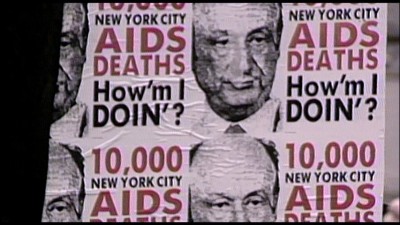
David France's How to Survive a Plague does something important -- compiling together and preserving the history of one of America's most effective protest movements, the AIDS-awareness/advocacy group ACT-UP -- and it does it well, organizing unshaped tons of archival footage into a "story" that provides a fascinating, well-organized, eminently watchable cross-section of the individuals who made the movement, ultimately coalescing into a worthy snapshot of the organization's many confrontations and accomplishments, a picture that ranges far and wide while neither evading nor too-gleefully exposing the complications, differences, and conflicts that are bound to exist behind the even the most united and purpose-driven front. Yet even though the film doesn't purport to tell the whole story (an impossibility), there still seems to be a dimension missing, some route of deeper access into the harrowing physical and emotional experiences (exacerbated profoundly by the unbearable ignorance dominating American politics and much of society at the time) that gave rise to the passion we see playing out in the form of ACT-UP's bold civil-disobedient actions. France's film is made with skill and care, it's capable of sweeping you up in its subject, and it has a real value to it on the informational, historical, and politicizing fronts. But it may be that the most eye-opening, galvanizing truths -- the torment, anger, and desperation of an era where AIDS was spreading like wildfire and had no treatment because of social prejudice and government neglect -- lie elsewhere, and that France simply reached the parameters of how close a documentary can effectively get us, demonstrating in the process both the not-inconsiderable properties available to this kind of film for letting us glimpse a bygone reality, and its limitations for conveying the murkier depths and meanings of how that reality was experienced, its less outwardly visible textures and its ineffable emotional endurance tests. Recommended.
|
| Popular Reviews |
| Sponsored Links |
|
|
| Sponsored Links |
|
|
| Release List | Reviews | Shop | Newsletter | Forum | DVD Giveaways | Blu-Ray | Advertise |
|
Copyright 2024 DVDTalk.com All Rights Reserved. Legal Info, Privacy Policy, Terms of Use,
Manage Preferences,
Your Privacy Choices | |||||||









